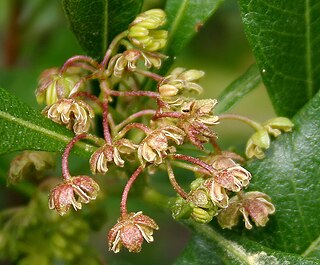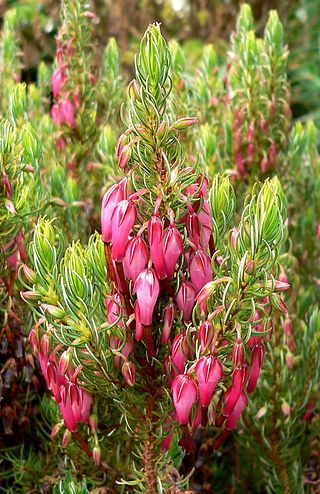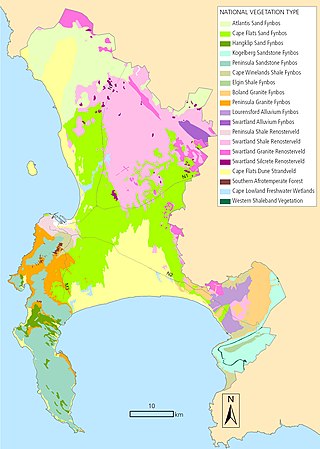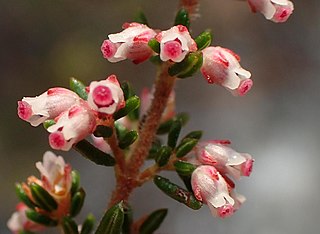
The Ericaceae are a family of flowering plants, commonly known as the heath or heather family, found most commonly in acidic and infertile growing conditions. The family is large, with c. 4250 known species spread across 124 genera, making it the 14th most species-rich family of flowering plants. The many well known and economically important members of the Ericaceae include the cranberry, blueberry, huckleberry, rhododendron, and various common heaths and heathers.

Erica is a genus of roughly 857 species of flowering plants in the family Ericaceae. The English common names heath and heather are shared by some closely related genera of similar appearance. The genus Calluna was formerly included in Erica – it differs in having even smaller scale-leaves, and the flower corolla consisting of separate petals. Erica is sometimes referred to as "winter heather" to distinguish it from Calluna "summer heather".

Daboecia, or St. Dabeoc's heath, is a small genus of flowering plants in the family Ericaceae, containing two evergreen shrubs, closely related to the genus Erica. They are native to cliffs and heathland in southern Atlantic Europe and the Azores.

The Portulacaceae are a family of flowering plants, comprising 115 species in a single genus Portulaca. Formerly some 20 genera with about 500 species, were placed there, but it is now restricted to encompass only one genus, the other genera being placed elsewhere. The family has been recognised by most taxonomists, and is also known as the purslane family. It has a cosmopolitan distribution, with the highest diversity in semiarid regions of the Southern Hemisphere in Africa, Australia, and South America, but with a few species also extending north into Arctic regions. The family is very similar to the Caryophyllaceae, differing in the calyx, which has only two sepals.

Dodonaea viscosa, also known as the broadleaf hopbush, is a species of flowering plant in the Dodonaea (hopbush) genus that has a cosmopolitan distribution in tropical, subtropical and warm temperate regions of Africa, the Americas, southern Asia and Australasia. Dodonaea is part of Sapindaceae, the soapberry family.

Erica plukenetii is a species of flowering plant native to the Cape region of South Africa. It belongs to the genus Erica. The species is morphologically variable, and five subspecies are recognised. The larger, variably coloured, flowers of E. plukenetii ssp. plukenetii are pollinated by sunbirds, whilst the smaller, exclusively white, flowers of E. plukenetii ssp. breviflora are moth pollinated.

Aspalathus is a genus of flowering plants in the family Fabaceae. The yellow flowers and spiny habit of some species have suggested a resemblance to Ulex europaeus, the thorny "English gorse" Accordingly, "Cape Gorse" has been proposed as a common name although the resemblance is largely superficial; for instance, gorse is thorny, whereas Aspalathus species are variously spiny or unarmed. The genus belongs to the subfamily Faboideae. There are over 270 species, mainly endemic to southwestern fynbos regions in South Africa, with over fifty occurring on the Cape Peninsula alone. The species Aspalathus linearis is commercially important, being farmed as the source of Rooibos tea.

Edward (Ted) George Hudson Oliver, is a South African Botanist and author. He is an expert in heathers. He has discovered and named several species. Oliver is the recognized world authority on the subfamily Ericoideae.

The Biodiversity of Cape Town is the variety and variability of life within the geographical extent of the City of Cape Town metropolitan municipality, excluding the Prince Edward Islands. The terrestrial vegetation is particularly diverse and much of it is endemic to the city and its vicinity. Terrestrial and freshwater animal life is heavily impacted by urban development and habitat degradation. Marine life of the waters immediately adjacent to the city along the Cape Peninsula and in False Bay is also diverse, and while also impacted by human activity, the habitats are relatively intact.

Erica abietina is a species of erica that is endemic to the Cape Peninsula of the Western Cape, South Africa. E. abietina includes four subspecies with often highly restricted distributions and distinctive flower colours. Previous delimitation of the species has included a further three subspecies which proved to be more distantly related to Cape Peninsula endemic E. abietina subspecies and are now classified under Erica grandiflora L.f. and Erica situshiemalis E.G.H.Oliv. & Pirie.

Vexatorella is a genus containing four species of flowering plant, commonly known as vexators, in the family Proteaceae. The genus is endemic to the Cape Floristic Region of South Africa. The name means “little trouble-maker”, given with reference to the initial difficulties of placing V. latebrosa within the family. All species are shrubs which occur in dry fynbos habitats on the fringes of the Succulent Karoo ecoregion. The inflorescences are similar to those of the related leucospermums but also share features of the leucadendrons, with the floral bracts becoming woody and enlarged following pollination. The flowers are insect-pollinated, with the seeds dispersed by ants (myrmecochory).

Erica peltata is a species of Erica heath endemic to the fynbos region of the Western Cape Province, South Africa.
Erica comorensis is a species of flowering plant (angiosperms) in the heather family (Ericaceae). It is endemic to the Comoro Islands in the Indian Ocean. It grows from .5 to 2 meters high.

Dudleya saxosasubsp. aloides is a species of perennial succulent plant in the family Crassulaceae known by the common names desert dudleya or desert savior. It is a rosette-forming species widely distributed throughout the Peninsular Ranges and desert mountains of California in the United States. It is characterized by bright-yellow or greenish-yellow flowers, and can be found in shaded crevices and slopes. Plants in western half of the range may grade into Dudleya lanceolata.
Erica purgatoriensis is a species of flowering plant in the heath and heather family Ericaceae, native to the Cape Provinces of South Africa. Known from only one location, a wetland alongside a road, and with around 500 mature individuals occupying an area of about one hectare, it is assessed as Vulnerable.















